汽车车牌识别系统的设计文献综述
汽车车牌识别系统-车牌定位子系统的设计与实现大学毕业论文外文文献翻译及原文
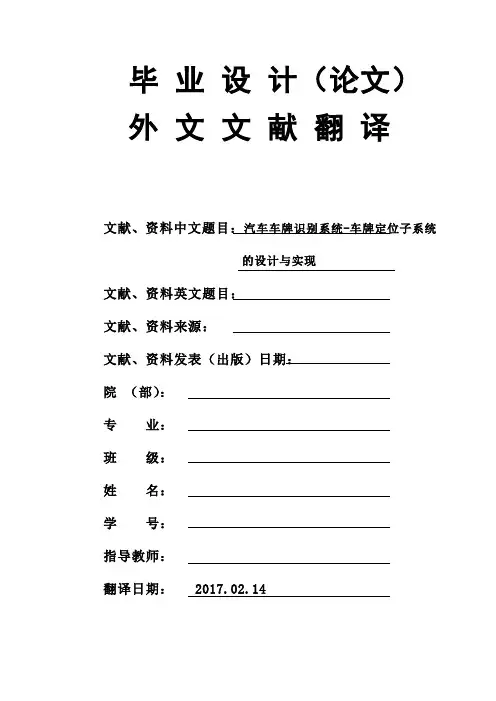
毕业设计(论文)外文文献翻译文献、资料中文题目:汽车车牌识别系统-车牌定位子系统的设计与实现文献、资料英文题目:文献、资料来源:文献、资料发表(出版)日期:院(部):专业:班级:姓名:学号:指导教师:翻译日期: 2017.02.14汽车车牌识别系统---车牌定位子系统的设计与实现摘要汽车车牌识别系统是近几年发展起来的计算机视觉和模式识别技术在智能交通领域应用的重要研究课题之一。
在车牌自动识别系统中,首先要将车牌从所获取的图像中分割出来实现车牌定位,这是进行车牌字符识别的重要步骤,定位的准确与否直接影响车牌识别率。
本次毕业设计首先对车牌识别系统的现状和已有的技术进行了深入的研究,在此基础上设计并开发了一个基于MATLAB的车牌定位系统,通过编写MATLAB文件,对各种车辆图像处理方法进行分析、比较,最终确定了车牌预处理、车牌粗定位和精定位的方法。
本次设计采取的是基于微分的边缘检测,先从经过边缘提取后的车辆图像中提取车牌特征,进行分析处理,从而初步定出车牌的区域,再利用车牌的先验知识和分布特征对车牌区域二值化图像进行处理,从而得到车牌的精确区域,并且取得了较好的定位结果。
关键词:图像采集,图像预处理,边缘检测,二值化,车牌定位ENGLISH SUBJECTABSTRACTThe subject of the automatic recognition of license plate is one of the most significant subjects that are improved from the connection of computer vision and pattern recognition. In LPSR, the first step is for locating the license plate in the captured image which is very important for character recognition. The recognition correction rate of license plate is governed by accurate degree of license plate location.Firstly, the paper gives a deep research on the status and technique of the plate license recognition system. On the basis of research, a solution of plate license recognition system is proposed through the software MATLAB,by the M-files several of methods in image manipulation are compared and analyzed. The methods based on edge map and das differential analysis is used in the process of the localization of the license plate, extracting the characteristics of the license plate in the car images after being checked up for the edge, and then analyzing and processing until the probably area of license plate is extracted,then come out the resolutions for localization of the car plate.KEY WORDS:imageacquisition,image preprocessing,edge detection,binarization,licence,license plate location前言 (1)第1章绪论 (2)§1.1 课题研究的背景 (2)§1.2 车牌的特征 (2)§1.3 国内外车辆牌照识别技术现状 (3)§1.4车牌识别技术的应用情况 (4)§1.5 车牌识别技术的发展趋势 (5)§1.6车牌定位的意义 (6)第2章 MATLAB简介 (7)§2.1 MATLAB发展历史 (7)§2.2 MATLAB的语言特点 (7)第3章图像预处理 (10)§3.1 灰度变换 (10)§3.2 图像增强 (11)§3. 3 图像边缘提取及二值化 (13)§3. 4 形态学滤波 (18)第4章车牌定位 (21)§4.1车牌定位的主要方法 (21)§4.1.1基于直线检测的方法 (22)§4.1.2 基于阈值化的方法 (22)§4.1.3 基于灰度边缘检测方法 (22)§4.1.4 基于彩色图像的车牌定位方法 (25)§4.2 车牌提取 (26)结论 (30)参考文献 (31)致谢 (33)随着交通问题的日益严重,智能交通系统应运而生。
文献综述车牌识别
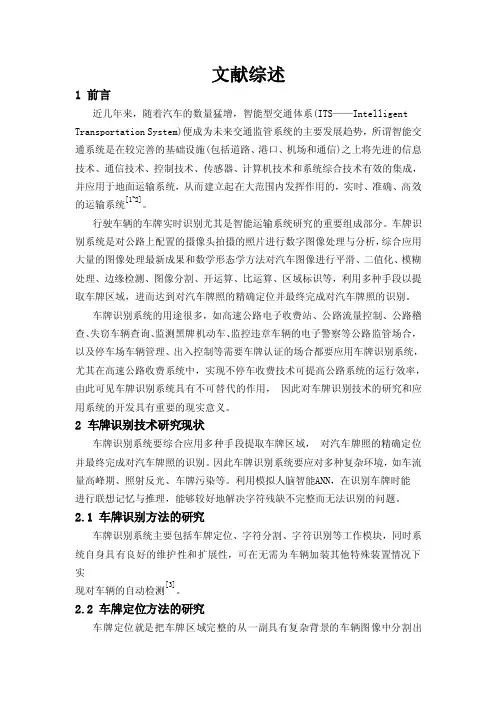
文献综述1前言近几年来,随着汽车的数量猛增,智能型交通体系(ITS——Intel ligent Tran sporta tion S ystem)便成为未来交通监管系统的主要发展趋势,所谓智能交通系统是在较完善的基础设施(包括道路、港口、机场和通信)之上将先进的信息技术、通信技术、控制技术、传感器、计算机技术和系统综合技术有效的集成,并应用于地面运输系统,从而建立起在大范围内发挥作用的,实时、准确、高效的运输系统[1~2]。
行驶车辆的车牌实时识别尤其是智能运输系统研究的重要组成部分。
车牌识别系统是对公路上配置的摄像头拍摄的照片进行数字图像处理与分析,综合应用大量的图像处理最新成果和数学形态学方法对汽车图像进行平滑、二值化、模糊处理、边缘检测、图像分割、开运算、比运算、区域标识等,利用多种手段以提取车牌区域,进而达到对汽车牌照的精确定位并最终完成对汽车牌照的识别。
车牌识别系统的用途很多,如高速公路电子收费站、公路流量控制、公路稽查、失窃车辆查询、监测黑牌机动车、监控违章车辆的电子警察等公路监管场合,以及停车场车辆管理、出入控制等需要车牌认证的场合都要应用车牌识别系统,尤其在高速公路收费系统中,实现不停车收费技术可提高公路系统的运行效率,由此可见车牌识别系统具有不可替代的作用,因此对车牌识别技术的研究和应用系统的开发具有重要的现实意义。
2 车牌识别技术研究现状车牌识别系统要综合应用多种手段提取车牌区域,对汽车牌照的精确定位并最终完成对汽车牌照的识别。
因此车牌识别系统要应对多种复杂环境,如车流量高峰期、照射反光、车牌污染等。
利用模拟人脑智能A NN,在识别车牌时能进行联想记忆与推理,能够较好地解决字符残缺不完整而无法识别的问题。
车牌识别系统的设计说明
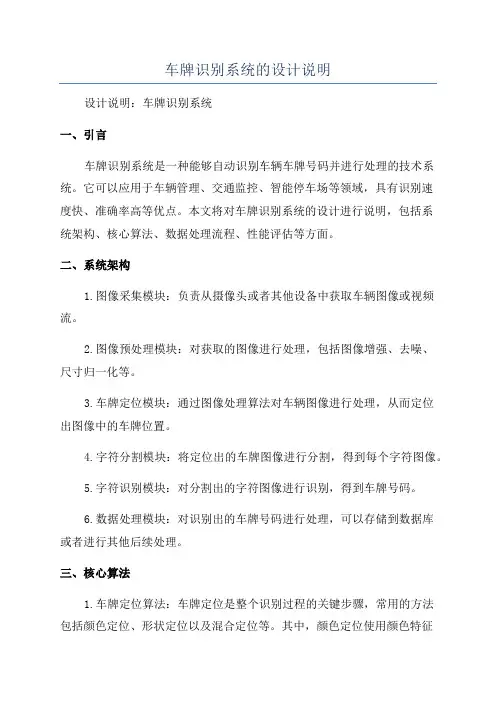
车牌识别系统的设计说明设计说明:车牌识别系统一、引言车牌识别系统是一种能够自动识别车辆车牌号码并进行处理的技术系统。
它可以应用于车辆管理、交通监控、智能停车场等领域,具有识别速度快、准确率高等优点。
本文将对车牌识别系统的设计进行说明,包括系统架构、核心算法、数据处理流程、性能评估等方面。
二、系统架构1.图像采集模块:负责从摄像头或者其他设备中获取车辆图像或视频流。
2.图像预处理模块:对获取的图像进行处理,包括图像增强、去噪、尺寸归一化等。
3.车牌定位模块:通过图像处理算法对车辆图像进行处理,从而定位出图像中的车牌位置。
4.字符分割模块:将定位出的车牌图像进行分割,得到每个字符图像。
5.字符识别模块:对分割出的字符图像进行识别,得到车牌号码。
6.数据处理模块:对识别出的车牌号码进行处理,可以存储到数据库或者进行其他后续处理。
三、核心算法1.车牌定位算法:车牌定位是整个识别过程的关键步骤,常用的方法包括颜色定位、形状定位以及混合定位等。
其中,颜色定位使用颜色特征区分车牌与背景,形状定位使用形状特征匹配车牌区域,混合定位则是结合颜色和形状特征进行定位。
2.字符分割算法:字符分割是将车牌图像中的字符区域分割出来的过程,常用的方法包括垂直边缘检测、投影法、连通区域划分等。
这些方法可以通过对像素点进行分析,确定字符之间的间隔和边界,实现字符的准确分割。
3.字符识别算法:字符识别是根据字符图像的特征进行匹配与识别的过程,常用的方法包括模板匹配、神经网络、支持向量机等。
这些方法可以通过建立字符特征库,并将输入的字符图像与特征库进行比对,从而获得识别结果。
四、数据处理流程1.图像采集:从摄像头或者其他设备中获取车辆图像或视频流。
2.图像预处理:对获取的图像进行处理,包括图像增强、去噪、尺寸归一化等。
3.车牌定位:通过图像处理算法对车辆图像进行处理,从而定位出图像中的车牌位置。
4.字符分割:将定位出的车牌图像进行分割,得到每个字符图像。
车牌识别毕业设计论文
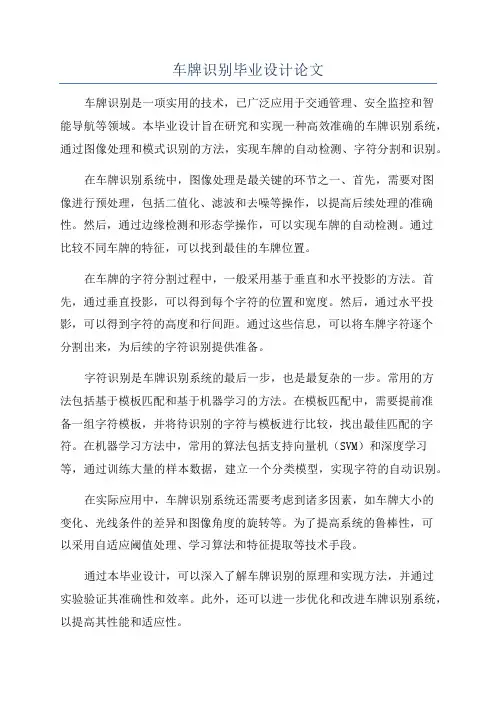
车牌识别毕业设计论文车牌识别是一项实用的技术,已广泛应用于交通管理、安全监控和智能导航等领域。
本毕业设计旨在研究和实现一种高效准确的车牌识别系统,通过图像处理和模式识别的方法,实现车牌的自动检测、字符分割和识别。
在车牌识别系统中,图像处理是最关键的环节之一、首先,需要对图像进行预处理,包括二值化、滤波和去噪等操作,以提高后续处理的准确性。
然后,通过边缘检测和形态学操作,可以实现车牌的自动检测。
通过比较不同车牌的特征,可以找到最佳的车牌位置。
在车牌的字符分割过程中,一般采用基于垂直和水平投影的方法。
首先,通过垂直投影,可以得到每个字符的位置和宽度。
然后,通过水平投影,可以得到字符的高度和行间距。
通过这些信息,可以将车牌字符逐个分割出来,为后续的字符识别提供准备。
字符识别是车牌识别系统的最后一步,也是最复杂的一步。
常用的方法包括基于模板匹配和基于机器学习的方法。
在模板匹配中,需要提前准备一组字符模板,并将待识别的字符与模板进行比较,找出最佳匹配的字符。
在机器学习方法中,常用的算法包括支持向量机(SVM)和深度学习等,通过训练大量的样本数据,建立一个分类模型,实现字符的自动识别。
在实际应用中,车牌识别系统还需要考虑到诸多因素,如车牌大小的变化、光线条件的差异和图像角度的旋转等。
为了提高系统的鲁棒性,可以采用自适应阈值处理、学习算法和特征提取等技术手段。
通过本毕业设计,可以深入了解车牌识别的原理和实现方法,并通过实验验证其准确性和效率。
此外,还可以进一步优化和改进车牌识别系统,以提高其性能和适应性。
车牌识别外文翻译文献综述
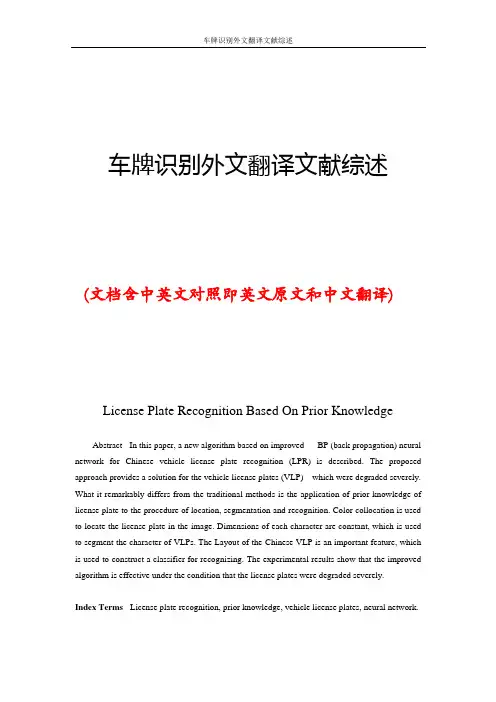
车牌识别外文翻译文献综述(文档含中英文对照即英文原文和中文翻译)License Plate Recognition Based On Prior KnowledgeAbstract - In this paper, a new algorithm based on improved BP (back propagation) neural network for Chinese vehicle license plate recognition (LPR) is described. The proposed approach provides a solution for the vehicle license plates (VLP) which were degraded severely. What it remarkably differs from the traditional methods is the application of prior knowledge of license plate to the procedure of location, segmentation and recognition. Color collocation is used to locate the license plate in the image. Dimensions of each character are constant, which is used to segment the character of VLPs. The Layout of the Chinese VLP is an important feature, which is used to construct a classifier for recognizing. The experimental results show that the improved algorithm is effective under the condition that the license plates were degraded severely.Index Terms - License plate recognition, prior knowledge, vehicle license plates, neural network.I. INTRODUCTIONVehicle License-Plate (VLP) recognition is a very interesting but difficult problem. It is important in a number of applications such as weight-and-speed-limit, red traffic infringement, road surveys and park security [1]. VLP recognition system consists of the plate location, the characters segmentation, and the characters recognition. These tasks become more sophisticated when dealing with plate images taken in various inclined angles or under various lighting, weather condition and cleanliness of the plate. Because this problem is usually used in real-time systems, it requires not only accuracy but also fast processing. Most existing VLP recognition methods [2], [3], [4], [5] reduce the complexity and increase the recognition rate by using some specific features of local VLPs and establishing some constrains on the position, distance from the camera to vehicles, and the inclined angles. In addition, neural network was used to increase the recognition rate [6], [7] but the traditional recognition methods seldom consider the prior knowledge of the local VLPs. In this paper, we proposed a new improved learning method of BP algorithm based on specific features of Chinese VLPs. The proposed algorithm overcomes the low speed convergence of BP neural network [8] and remarkable increases the recognition rate especially under the condition that the license plate images were degrade severely.II. SPECIFIC FEATURES OF CHINESE VLPSA. DimensionsAccording to the guideline for vehicle inspection [9], all license plates must be rectangular and have the dimensions and have all 7 characters written in a single line. Under practical environments, the distance from the camera to vehicles and the inclined angles are constant, so all characters of the license plate have a fixed width, and the distance between the medium axes of two adjoining characters is fixed and the ratio between width and height is nearly constant. Those features can be used to locate the plate and segment the individual character. B. Color collocation of the plateThere are four kinds of color collocation for the Chinese vehicle license plate .These color collocations are shown in table I.TABLE IMoreover, military vehicle and police wagon plates contain a red character which belongsto a specific character set. This feature can be used to improve the recognition rate.C. Layout of the Chinese VLPSThe criterion of the vehicle license plate defines the characters layout of Chinese license plate. All standard license plates contain Chinese characters, numbers and letters which are shown in Fig.1. The first one is a Chinese character which is an abbreviation of Chinese provinces. The second one is a letter ranging from A to Z except the letter I. The third and fourth ones are letters or numbers. The fifth to seventh ones are numbers ranging from 0 to 9 only. However the first or the seventh ones may be red characters in special plates (as shown in Fig.1). After segmentation process the individual character is extracted. Taking advantage of the layout and color collocation prior knowledge, the individual character will enter one of the classes: abbreviations of Chinese provinces set, letters set, letters or numbers set, number set, special characters set.(a)Typical layout(b) Special characterFig.1 The layout of the Chinese license plateIII. THE PROPOSED ALGORITHMThis algorithm consists of four modules: VLP location, character segmentation, character classification and character recognition. The main steps of the flowchartof LPR system are shown in Fig. 2.Firstly the license plate is located in an input image and characters are segmented. Then every individual character image enters the classifier to decide which class it belongs to, and finally the BP network decides which character the character image represents.Fig.2 The flowchart of LPR systemA. Preprocessing the license plate1) VLP LocationThis process sufficiently utilizes the color feature such as color collocation, color centers and distribution in the plate region, which are described in section II. These color features can be used to eliminate the disturbance of the fake plate ’s regions. The flowchart of the plate location is shown in Fig. 3.Fig.3 The flowchart of the plate location algorithmThe regions which structure and texture similar to the vehicle plate are extracted. The process is described as followed:(1)Characters edge detection Binary image segmentingCandidate image detectionVehicle plate extractionImage acquisitionPlate locationCharacters segmentationclassifierChinesecharacter Letter Letter or number Number Special characterCharacters recognition(2)Here, the Gaussian variance is set to be less than W/3 (W is the character stroke width), P gets its maximum value M at the center of the stroke. After convolution, binarization is so1performed according to a threshold which equals T * M (T<0.5). Median filter is used to preserve the edge gradient and eliminate isolated noise of the binary image. An N * N rectangle median filter is set, and N represents the odd integer mostly close to W.Morphology closing operation can be used to extract the candidate region. The confidence degree of candidate region for being a license plate is verified according to the aspect ratio and areas. Here, the aspect ratio is set between 1.5 and 4 for the reason of inclination. The prior knowledge of color collocation is used to locate plate region exactly. The locating process of the license plate is shown in Fig. 4.Fig. 4 The whole process of locating license plate2) Character segmentationThis part presents an algorithm for character segmentation based on prior knowledge, using character width, fixed number of characters, the ratio of height to width of a character, and so on. The flowchart of the character segmentation is shown in Fig. 5.Fig. 5 The flowchart of the character segmentationFirstly, preprocess the license the plate image, such as uneven illumination correction, contrast enhancement, incline correction and edge enhancement operations; secondly, eliminating space mark which appears between the second character and the third character; thirdly, merging the segmented fragments of the characters. In China, all standard license plates contain only 7 characters (see Fig. 1). If the number of segmented characters is larger than seven, the merging process must be performed. Table II shows the merging process. Finally, extracting the individual character’image based on the number and the width of the character. Fig. 6 shows the segmentation results. (a) The incline and broken plate image, (b) the incline and distort plate image, (c)the serious fade plate image, (d) the smut license plate image.TABLEIIEnd of algorithmwhere Nf is the number of character segments, MaxF is the number of the license plate, and i is the index of each character segment.The medium point of each segmented character is determined by:(3)where 1i S is the initial coordinates for the character segment, and 2i S is the final coordinate for the character segment. The distance between two consecutive medium points is calculated by:(4)Fig.6 The segmentation resultsB. Using specific prior knowledge for recognitionThe layout of the Chinese VLP is an important feature (as described in the section II), which can be used to construct a classifier for recognizing. The recognizing procedure adopted conjugate gradient descent fast learning method, which is an improved learning method of BP neural network[10]. Conjugate gradient descent, which employs a series of line searches in weight or parameter space. One picks the first descent direction and moves along that direction until the minimum in error is reached. The second descent direction is then computed: this direction the “conjugate direction ” is the one along which the gradient does not change its direction will not “spoil ” the contribution from the previous descent iterations. This algorithm adopted topology 625-35-N as shown in Fig. 7. The size of input value is 625 (25*25 ) and initial weights are with random values, desired output values have the same feature with the input values.Fig. 7 The network topologyAs Fig. 7 shows, there is a three-layer network which contains working signal feed forward operation and reverse propagation of error processes. The target parameter is t and the length of network output vectors is n. Sigmoid is the nonlinear transfer function, weights are initialized with random values, and changed in a direction that will reduce the errors.The algorithm was trained with 1000 images of different background and illumination most of which were degrade severely. After preprocessing process, the individual characters are stored. All characters used for training and testing have the same size (25*25 ).The integrated process for license plate recognition consists of the following steps:1) Feature extractingThe feature vectors from separated character images have direct effects on the recognition rate. Many methods can be used to extract feature of the image samples, e.g. statistics of data at vertical direction, edge and shape, framework and all pixels values. Based on extensive experiments, all pixels values method is used to construct feature vectors. Each character was reshaped into a column of 625 rows’feature vector. These feature vectors are divided into two categories which can be used for training process and testing process.2) Training modelThe layout of the Chinese VLP is an important feature, which can be used to construct a classifier for training, so five categories are divided. The training process of numbers is shown in Fig. 8.Fig. 8 The architecture of a neural network for character recognitionAs Fig. 8 shows, firstly the classifier decides the class of the input feature vector, and then the feature vector enters the neural network correspondingly. After the training process the optimum parameters of the net are stored for recognition. The training and testing process is summarized in Fig. 9.(a) Training process(b)Testing processFig.9 The recognition process3) Recognizing modelAfter training process there are five nets which were completely trained and the optimum parameters were stored. The untrained feature vectors are used to test the net, the performance of the recognition system is shown in Table III. The license plate recognition system is Input character vectorfor recognition Neural network output Input character vectorfor recognition Neural network Target outputerrorcharacterized by the recognition rate which is defined by equation (5).Recognition rate =(number of correctly read characters)/ (number of found characters) (5)TABLE IIIIV. COMPARISON OF THE RECOGNITION RATE WITH OTHER METHODS In order to evaluate the proposed algorithm, two groups of experiments were conducted. One group is to compare the proposed method with the BP based recognition method [11]. The result is shown in table IV. The other group is to compare the proposed method with the method based on SVM [12].The result is shown in table V. The same training and test data set are used. The comparison results show that the proposed method performs better than the BP neural network and SVM counterpart.TABLE IVTABLE VV. CONCLUSIONIn this paper, we adopt a new improved learning method of BP algorithm based on specific features of Chinese VLPs. Color collocation and dimension are used in the preprocessing procedure, which makes location and segmentation more accurate. The Layout of the ChineseVLP is an important feature, which is used to construct a classifier for recognizing and makes the system performs well on scratch and inclined plate images. Experimental results show that the proposed method reduces the error rate and consumes less time. However, it still has a few errors when dealing with specially bad quality plates and characters similar to others. This often takes place among these characters (especially letter and number):3—8 4—A 8—B D—0. In order to improve the incorrect recognizing problem we try to add template-based model [13] at the end of the neural network.REFERENCES[1] P. Davies, N. Emmottand N. Ayland,“License Plate Recognition Technology for Toll Violation Enforcement”Proceedings of IEE Colloquium on Image analysis for Transport Applications, Vol. 035, pp.7/1-7/5, February16, 1990.[2] V. Koval,V. Turchenko,V. Kochan, A. Sachenko, G. Markowsky,“Smart. License Plate Recognition System Based on Image Processing Using Neural Network”IEEE International Workshop on Intelligent Data Acquisition and Advanced Computing System: Technology Applications8-10September2003.[3] Abdullah, S.N.H.S.; Khalid, M.;Yusof, R.; Omar, K.“License Plate Recognition using multi-cluster and Multilayer Neural Networks”Information and Communication Technologies, 2006. ICTTA '06. 2nd Volume1, 24-28April2006Page(s):1818–1823.[4] Nathan, V.S.L.; Ramkumar, J.; Kamakshi Priya, S.“New approaches for license plate recognition system”Intelligent Sensing and Information Processing, 2004. Proceedings of International Conference on2004Page(s):149–152.[5] Mei Yu; Yong Deak Kim,“An approach to Korean license plate recognition based on vertical edge matching”Volume4, 8-11Oct. 2000Page(s):2975 - 2980vol.4. [6] Tindall, D.W.”Application of neural network techniques to automatic licence plate recognition”Security and Detection, 1995., European Convention on16-18May1995Page(s):81–85.[7] Aghdasi, F.; Ndungo, H. “Automatic licence plate recognition system”AFRICON, 2004. 7th AFRICON Conference in AfricaVolume1, 2004Page(s):45 - 50Vol.1[8] Richard O.Duda Peter E.Hart David G.Stork,“Pattern Classification Second Edition”PP 333–373.[9] Standard for vehicle license plate number in the People's Republic of China (GA36-92).[10] Richard O.Duda Peter E.Hart David G.Stork,“Pattern Classification Second Edition”PP373–376.[11] Nukano, T.; Fukumi, M.;Khalid, M.;“Vehicle license plate character recognition by neural networks”Intelligent Signal Processing and Communication Systems, 2004. ISPACS 2004. Proceedings of2004International Symposium on18-19Nov. 2004Page(s):771–775.[12] Xiaojun Chi; Junyu Dong;Aihua Liu; Huiyu Zhou,“A Simple Method for Chinese License Plate Recognition Based on Support Vector Machine”Communications, Circuits and Systems Proceedings, 2006International Conference on Volume3, June2006Page(s):2141 - 2145.[13] Yo-Ping Huang;Shi-Yong Lai;Wei-Po Chuang, A template-based model for license plate recognition”Networking, Sensing and Control, 2004IEEE International Conference on Volume2, 2004Page(s):737 - 742Vol.2.译文:基于先验知识的车牌识别摘要-本文基于一种新的改进的BP(反向传播)神经网络算法对中国的车辆车牌识别(LPR)进行了介绍。
车牌识别的相关文献
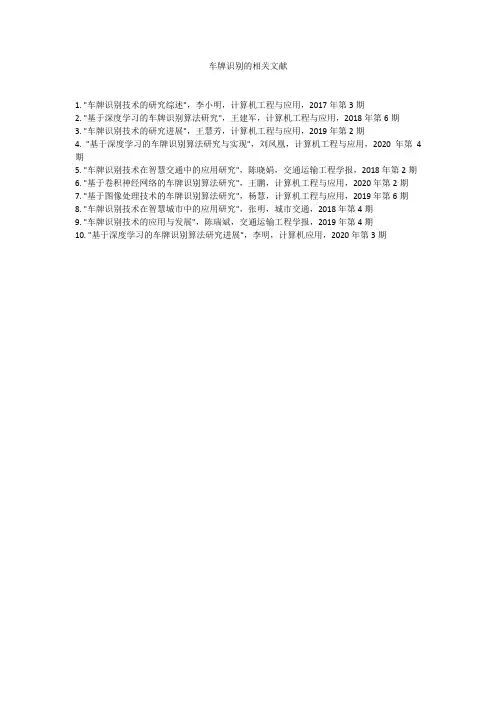
车牌识别的相关文献
1. "车牌识别技术的研究综述",李小明,计算机工程与应用,2017年第3期
2. "基于深度学习的车牌识别算法研究",王建军,计算机工程与应用,2018年第6期
3. "车牌识别技术的研究进展",王慧芳,计算机工程与应用,2019年第2期
4. "基于深度学习的车牌识别算法研究与实现",刘凤凰,计算机工程与应用,2020年第4期
5. "车牌识别技术在智慧交通中的应用研究",陈晓娟,交通运输工程学报,2018年第2期
6. "基于卷积神经网络的车牌识别算法研究",王鹏,计算机工程与应用,2020年第2期
7. "基于图像处理技术的车牌识别算法研究",杨慧,计算机工程与应用,2019年第6期
8. "车牌识别技术在智慧城市中的应用研究",张明,城市交通,2018年第4期
9. "车牌识别技术的应用与发展",陈瑞斌,交通运输工程学报,2019年第4期
10. "基于深度学习的车牌识别算法研究进展",李明,计算机应用,2020年第3期。
车牌识别系统论文
摘要车牌识别系统(LPRS)是智能交通系统的重要组成部分。
随着机动车辆数量的大幅度增加以及计算机技术的发展,人们对交通控制系统的要求显著提高。
因而智能交通系统被广泛地应用于交通控制系统当中,比如高速公路收费、停车场车辆管理、违章车辆监控、交通诱导控制等场合。
这使得车牌识别系统也得到了更广泛的关注。
与传统的车辆管理方法比较,车牌识别系统可以大大提高交通管理的效率和水平,帮助实现车辆管理的规范化。
本文主要介绍了基于MFC开发的有关数字图像处理的车牌数字识别系统。
系统是利用单张包含车牌的静态图片进行识别的,整个识别过程主要分为车牌定位和字符分割和字符识别三个大的模块。
而其中的字符识别是系统的核心部分。
字符识别目前运用的最多的就是神经网络和模板匹配的方法,本文所介绍的就是基于模板匹配的方法来实现车牌数字的识别。
过程中也相应结合了特征提取、直方图统计等一系列方法。
从实验得知,这种模板匹配的方法实现简单,且容易理解,在确保识别准确率的前提下,可以提高识别的效率,使得系统在比较准确地定位了车牌及分割出字符后,能更准确地实现字符的识别。
关键字:车牌识别;MFC;模板匹配;特征提取AbstractLicense Plate Recognition System (LPRS) is the important part of Intelligent Transportation System. With the increase in the number of motor vehicles and the development of computer technology, the requirements for traffic control systems are significantly increased to people. Because Intelligent Transportation System is widely used in traffic control systems, such as highway tolling, parking vehicles’ management, Illegal vehicles monitoring, traffic guidance and control and so on. So it makes the license Plate Recognition System has also been a more widespread concern. Compared to the traditional methods of vehicle management, license Plate Recognition System can greatly improve the efficiency and level of traffic management to help achieve the standardization of vehicle management.This paper mainly introduces the license Plate Number Recognition System which based on MFC and digital image processing. The system uses static images which contains a plate to recognize the numbers of the plates, the entire recognition process consists of three major modules, license plate location and character segmentation and character recognition. Character recognition is the core of the system. Neural network and template matching are mostly used in Character recognition currently, The Character recognition process introduced in this paper is based on template matching method, it also uses the feature extraction, Histogram statistics and a series of methods. From the experimental results, this method is simple and easy to understand, it can improve the efficiency of recognition , and ensure the accuracy of the recognition at the same time. When the system accurately locates the license plate and segments the characters, the method can recognize the characters accurately.Key word: License Plate Recognition; MFC; Template matching; Feature extraction目录1 绪论 (1)1.1研究的意义及目的 (1)1.2研究的现状及内容 (1)2 相关知识与技术 (3)2.1数字图像处理概述 (3)2.1.1 数字图像的存储和显示 (3)2.1.2 数字图像的处理 (3)2.2图像预处理相关技术 (3)2.2.1 图像灰度化技术 (3)2.2.2 边缘检测技术 (4)2.2.3 图像二值化技术 (7)2.3特征提取技术 (7)2.3.1 纹理特征提取技术 (7)2.3.2 形状和结构特征提取技术 (8)2.4图像分割技术 (8)2.5字符识别技术 (8)2.5.1 字符归一化技术 (8)2.5.2 改进的OPTA细化算法 (9)2.5.3 模板匹配 (10)2.6本章小结 (11)3 车牌数字识别系统的设计与实现 (12)3.1设计目标 (12)3.2系统分析 (12)3.3系统数据结构的设计 (12)3.4系统功能设计 (14)3.4.1 图片预处理功能 (14)3.4.2 车牌搜索与定位的实现 (14)3.4.3 字符分割算法设计 (15)3.4.4 字符归一化思想 (15)3.4.5 字符细化 (16)3.4.6 字符识别过程设计 (16)3.5本章小结 (16)4 系统实现与测试 (17)4.1系统开发环境与工具 (17)4.2实验结果 (17)4.2.1 打开车牌图片 (17)4.2.2 图片预处理 (17)4.2.3 车牌定位 (20)4.2.4 字符分割 (21)4.2.5 字符归一化和细化 (22)4.2.6 字符识别 (23)4.2.7 一键识别 (23)4.3本章小结 (24)5 结论 (25)5.1总结 (25)5.2展望 (25)参考文献 (26)致谢 ........................................................................................................... 错误!未定义书签。
车牌识别系统的设计汇总
车牌识别系统的设计1.摘要:汽车牌照自动识别系统是制约道路交通智能化的重要因素,包括车牌定位、字符分割和字符识别三个主要部分。
本文首先确定车辆牌照在原始图像中的水平位置和垂直位置,从而定位车辆牌照,然后采用局部投影进行字符分割。
在字符识别部分,提出了在无特征提取情况下基于支持向量机的车牌字符识别方法。
实验结果表明,本文提出的方法具有良好的识别性能。
随着公路逐渐普及,我国的公路交通事业发展迅速,所以人工管理方式已经不能满着实际的需要,微电子、通信和计算机技术在交通领域的应用极大地提高了交通管理效率。
汽车牌照的自动识别技术已经得到了广泛应用。
2.课程设计的目的:1).掌握数字信号处理的基本概念、基本理论和基本方法;2).掌握图像处理的常用算法;3).掌握在数字识别的应用及数字识别使用的基本算法;4).学会DSP的使用,掌握DSP的程序设计方法;5).学会用DSP对数字图像进行分析和处理。
3.课程设计内容:把车牌图像读取到DSP的SDRAM中,利用图像处理算法把数字从图像中定位出来;首先把图像二值化,二值化算法选择固定阈值、直方图或最大类间方差法,比较各个二值化算法的效果;对二值化的图像做边缘提取,选择Sobel或者Laplace边缘提取算法并比较效果;经过二值化和边缘提取后的图像,利用投影法定位数字在图像中的位置,并给出数字在图像中的外接矩形;利用CCS把处理结果显示出来。
4.设计原理由于车辆牌照是机动车唯一的管理标识符号,在交通管理中具有不可替代的作用,因此车辆牌照识别系统应具有很高的识别正确率,对环境光照条件、拍摄位置和车辆行驶速度等因素的影响应有较大的容阈,并且要求满足实时性要求。
图1 牌照识别系统原理图该系统是计算机图像处理与字符识别技术在智能化交通管理系统中的应用,它主要由图像的采集和预处理、牌照区域的定位和提取、牌照字符的分割和识别等几个部分组成,如图1 所示。
其基本工作过程如下:(1)当行驶的车辆经过时,触发埋设在固定位置的传感器,系统被唤醒处于工作状态;一旦连接摄像头光快门的光电传感器被触发,设置在车辆前方、后方和侧面的相机同时拍摄下车辆图像;(2)由摄像机或CCD 摄像头拍摄的含有车辆牌照的图像通视频卡输入计算机进行预处理,图像预处理包括图像转换、图像增强、滤波和水平较正等;(3)由检索模块进行牌照搜索与检测,定位并分割出包含牌照字符号码的矩形区域;(4)对牌照字符进行二值化并分割出单个字符,经归一化后输入字符识别系统进行识别。
(完整版)车牌识别系统的设计
车牌识别系统的设计1.摘要:汽车牌照自动识别系统是制约道路交通智能化的重要因素,包括车牌定位、字符分割和字符识别三个主要部分。
本文首先确定车辆牌照在原始图像中的水平位置和垂直位置,从而定位车辆牌照,然后采用局部投影进行字符分割。
在字符识别部分,提出了在无特征提取情况下基于支持向量机的车牌字符识别方法。
实验结果表明,本文提出的方法具有良好的识别性能。
随着公路逐渐普及,我国的公路交通事业发展迅速,所以人工管理方式已经不能满着实际的需要,微电子、通信和计算机技术在交通领域的应用极大地提高了交通管理效率。
汽车牌照的自动识别技术已经得到了广泛应用。
2.设计目的:1、使学生在巩固理论课上知识的同时,加强实践能力的提高,理论联系实践。
2、激发学生的研究潜能,提高学生的协作精神,锻炼学生的动手能力。
3.设计原理由于车辆牌照是机动车唯一的管理标识符号,在交通管理中具有不可替代的作用,因此车辆牌照识别系统应具有很高的识别正确率,对环境光照条件、拍摄位置和车辆行驶速度等因素的影响应有较大的容阈,并且要求满足实时性要求。
图1 牌照识别系统原理图该系统是计算机图像处理与字符识别技术在智能化交通管理系统中的应用,它主要由图像的采集和预处理、牌照区域的定位和提取、牌照字符的分割和识别等几个部分组成,如图1 所示。
其基本工作过程如下:(1)当行驶的车辆经过时,触发埋设在固定位置的传感器,系统被唤醒处于工作状态;一旦连接摄像头光快门的光电传感器被触发,设置在车辆前方、后方和侧面的相机同时拍摄下车辆图像;(2)由摄像机或CCD 摄像头拍摄的含有车辆牌照的图像通视频卡输入计算机进行预处理,图像预处理包括图像转换、图像增强、滤波和水平较正等;(3)由检索模块进行牌照搜索与检测,定位并分割出包含牌照字符号码的矩形区域;(4)对牌照字符进行二值化并分割出单个字符,经归一化后输入字符识别系统进行识别。
4.详细设计步骤4.1 提出总体设计方案。
车牌识别设计与实现毕业论文
目录摘要 (Ⅰ)Abstract (II)1 绪论 (1)1.1 课题的来源及意义 (1)1.2 课题主要研究的问题 (2)1.3 系统设计的目标及基本思路 (2)1.3.1 设计目标 (3)1.3.2 基本思路 (3)2 图像预处理 (5)2.1 汽车牌照的特征 (5)2.2 灰度变换 (6)2.3 图像增强 (8)2.4 图像边缘提取及二值化 (9)2.4.1 图像边缘提取 (9)2.4.2 灰度图像二值化 (17)2. 5 形态学滤波 (19)3 车牌定位方法研究 (23)3.1 车牌定位常用方法介绍 (23)3.1.1 基于纹理特征分析的定位方法 (23)3.1.2 基于数学形态学的定位方法 (23)3.1.3 基于边缘检测的定位方法 (23)3.1.4 基于小波分析的定位方法 (24)3.1.5 基于图像彩色信息的定位方法 (24)3.2 基于行扫描灰度跳变分析的车牌定位方法 (24)4 车牌识别方法研究 (26)4.1 牌照区域的分割和图像进一步处理 (26)4.1.1牌照区域的分割 (26)4.1.2车牌进一步处理 (26)4.2 字符的分割与归一化 (27)4.2.1字符分割 (28)4.2.2字符归一化 (28)4.3 字符的识别 (28)5 总结与展望 (27)5.1 总结 (32)5.2心得体会 (32)5.3展望 (33)致谢 (34)参考文献 (30)附录一 (31)摘要车牌识别系统作为智能交通系统的一个重要组成部分,在交通监控中占有很重要的地位。
车牌识别系统可分为图像预处理、车牌定位和字符识别3个部分,其中车牌定位作为获得车辆牌照图像的重要步骤,是后续的字符识别部分能否正确识别车牌字符的关键环节。
车牌定位系统实现对车辆牌照进行定位的功能,即从包含整个车辆的图像中找到车牌区域的位置,并对该车牌区域进行定位显示,将定位信息提供给字符识别部分。
针对车牌本身固有的特征,本文首先介绍了在车牌定位过程中常用的几种数字图像处理技术:图像的二值化处理、边缘检测和图像增强等。
- 1、下载文档前请自行甄别文档内容的完整性,平台不提供额外的编辑、内容补充、找答案等附加服务。
- 2、"仅部分预览"的文档,不可在线预览部分如存在完整性等问题,可反馈申请退款(可完整预览的文档不适用该条件!)。
- 3、如文档侵犯您的权益,请联系客服反馈,我们会尽快为您处理(人工客服工作时间:9:00-18:30)。
计算机图形学课程设计题目名称:汽车车牌识别系统的设计综述班级:学号:学生姓名:汽车车牌识别系统的设计综述摘要车牌的自动识别是计算机视觉、图像处理与模式识别技术在智能交通领域应用的重要研究课题之一, 是实现交通管理智能化的重要环节, 主要包括车牌识别、字符预处理和特征提取三个关键环节。
车牌识别包括车牌定位、灰度(或彩色)图像二值化、字符切分及字符识别等。
图像预处理包括图像灰度变换、图像增强、图像二值化、梯度锐化、噪声去除、倾斜度调整、车牌边框去除、字符分割、尺寸标准归一化、紧缩重排。
特征提取本文采用逐象素特征提取法来对支付进行识别。
理论上,本系统可以对中国大陆普通汽车车牌的字符进行识别。
关键词:车牌识别,图像预处理,特征提取引言1.1 问题概述随着我国汽车产业的飞速发展,大量在公共场合的汽车需要得到监管,为了更好地进行管理,必须对车辆进行一种确认,而车牌识别就是其中最有效的确认方法,汽车车牌识别VLPR 是Vehicle License Plate Recognition 的简称,他是智能交通系统(Intelligent Transportation Systems,ITS)的一个重要组成部分。
车牌识别技术的运用使得“大输入小输出”成为了可能——输入一幅很大存储量的图像,输出时仅仅是很小存储量的数字,这必然使得其在大量存储和管理数据库相连等方面有无可替代的优越性。
车牌识别技术在高速公路收费站、路口监测(电子警察)、大型停车场等场所具有广阔的发展前景。
1.2 目的和意义车牌识别LPR[1]是智能交通系统(ITS)的一个重要组成部分。
在社会生活,治安管理等方面有很大的作用。
车牌识别技术的运用使得“大输入小输出”成为了可能——输入一幅很大存储量的图像,输出时仅仅是很小存储量的数字,这必然使得其在大量存储和管理数据库相连等方面有无可替代的优越性。
由于光照、气候引起的车牌图像上字符光照不均,车牌本身污损造成的字符笔画不清和字符间粘连,汽车行驶速度较快,使拍摄出的车牌字符产生变形、模糊不清,因此图像需要增强。
另外又由于拍摄角度及拍摄点的高度、路面的倾斜等情况造成了车牌图像的倾斜,从而需要对车牌进行校正。
另外字符的识别也是一个重点问题。
1.3 思路和方法借助数字图像处理和模式识别技术,我们对车牌图像依次进行以下处理:彩色的256 色的BMP 图进行灰度转换->图像增强->图像二值化->梯度锐化(Roberts 梯度算子)->离散点噪声去除->倾斜度调整->边框切除->字符切割->字符尺寸归一化->字符紧缩重排->神经网络的字符识别,最后得出车牌字符。
正文2.1 模式识别概述2.1.1 模式识别概述模式识别(Pattern Recognition)是人类的一项基本智能,在日常生活中,人们经常在进行“模式识别”。
随着20世纪40年代计算机的出现以及50年代人工智能的兴起,人们当然也希望能用计算机来代替或扩展人类的部分脑力劳动。
(计算机)模式识别在20世纪60年代初迅速发展并成为一门新学科。
模式识别在数字图像处理和分析中占有非常重要的地位,识别所得到的结果往往接近于甚至就是整个数字图像处理和分析的最终结果。
模式识别属于图像分析的范畴,它所得到的结果是一副由明确意义的数值或符号构成的图像或图形文件,而不再是一副具有随机分布性质的图像。
模式识别的目的是对图像中的物体进行分类,或者可以说找出图像中有哪些物体。
分类的依据是从原始图像中提取的不同物体的特征,包括光谱特征、空间纹理特征和时间特征等。
因此,模式识别包括特征提取和分类两方面的内容[2]。
2.1.2 模式识别的步骤1.特征提取对于待识别的事物,进行特征提取,这些特征可以应用一定的数学方法通过计算进行量化表示。
特征提取过程产生一组特征,组合在一起就形成了特征向量,该特征向量所包含的信息与原始图像相比虽然有所减小,但它却包含了后续分类决策所必须的全部向量[2]。
2.决策分类确定每个物体应该归属的预定义类别,即每个物体(模式)被识别为某一特定类型,这是通过一个分类过程加以实现的[2]。
2.1.3 模式识别的应用1.字符识别2.生物特征提取3.遥感应用4.医学诊断[2]2.2 数字图像及数字图像处理图像信息使人类认识世界的重要知识来源,国外学者曾做过统计,人类所获得的外界信息70%以上来自眼睛摄取的图像。
在许多场合,没有其他形式比图像所传达的信息更为丰富和真确。
而通常意思上的图像都是一些连续的图像,所产生的图像信号也都是模拟信号,由于模拟信号自身的原因和对模拟处理手段的限制,人们把研究对象从模拟领域延伸到数字领域,于是产生了数字图像的概念。
本节将概述一下数字图像和数字图像处理[3]。
2.2.1.数字图像的基本概念一般的图像都是模拟图像,即图像上的信息是连续变化的模拟量。
如一幅黑白灰度照片上的物体是通过照片上各点的光的强度不同体现出来的,而照片上的光强是一个连续变化的量,也就是说,在一定的范围内,光强的任何值都可能体现。
对于这种模拟图像只能采用模拟的处理方式进行处理,例如按照光学原理用透镜将照片放大。
计算机不能接受和处理模拟信号,只有将图像在空间和灰度上都离散化为数字信号后,或者说将模拟图像变换为数字图像方能接受[4]。
而数字图像是将连续的模拟图像经过离散化处理后变成计算机能够辨识的点阵图像。
严格的数字图像是一个经过等矩形网格采样,对幅度进行等间隔量化的二维函数,因此,数字图像实际上就是被量化的二维采样数组[3]。
2.2.2 数字图像的两种存储形式1.位映射图像——即位图图像,它是每一个栅格内不同颜色的点来描述图像属性的,这些点就是常说的像素。
位图图像的分辨率不是独立的,因为描述图像的数据是对待特定大小栅格中的图像而言的,因此,编辑位图会改变它的显示质量,尤其是缩放位图,会因为图像在栅格内的重新分配而导致图像边缘粗糙。
在比位图图像本身的分辨率低的输出设备上显示位图也会降低图像的显示质量[3]。
2.矢量图像――指用包含颜色和位置属性的直线或曲线(即称为矢量)来描述的一种图像。
比如说一个椭圆,它就是包括由通过椭圆边缘的一些点组成的轮廓和轮廓内的点的两部分。
矢量图像是用一系列绘图指令来表示一幅图,如AutoCAD 中的绘图语句。
这种方法的本质是数学(更确切的说是几何学)公式描述一幅图像。
图像中的每一个形状都是一个完整的公式,称为一个对象。
对象是一个封闭的整体,所以定义图像上对象的变化和对象与其他对象的关系对计算机来说简单的,所有这些变化都不会影响到图像中的其他变化[3]。
2.2.3 数字图像处理的概念数字图像处理(Digital Image Processing)是一门关于如何使用计算机对图像进行处理的学科,就是对图像信息进行加工以满足人的视觉心理或者应用需求的行为。
图像处理的手段有光学方法、电子学(数学)方法。
后者正是要讨论数字图像处理,它是使用计算机加工处理图像,通过各种算法来实现对图像内容处理。
它通常有一个微型、小型、至大型计算机与图像处理机或有一个专用计算机来执行。
2.2.3.2 数字图像处理的目的1.提高图像的视感质量,以达到赏心悦目的目的;2.提取图像中所包含的某些特征或特殊信息,以便于计算机进行分析;3. 对图像数据进行变换、编码和压缩,以便于图像的存储和传输。
2.2.3.1 数字图像处理的主要内容1.图像获取、表示和表现;2.图像复原;3.图像增强;4.图像分割;5.图像分析6.图像重建;7.图像压缩编码。
2.2 系统的设计2.2.1 系统的流程图系统总流程图图2.1 系统总流程图●预处理部分流程图图2.2 图像预处理流程图●字符识别部分流程图图2.3 字符识别流程图2.2.2 图像采集(车牌定位)汽车牌照识别( Car License Plate Recognit ion,简称CLPR) 是实现智能交通系统的关键技术。
其核心技术在近年来取得了飞速的发展。
例如, 偷窃车辆的跟踪, 控制停车场车辆的进入, 地段通行的限制等等[ 5]。
但在识别正确率及系统稳定性方面仍有待提高, 仍然是一个研究热点。
在CLPR 系统中, 主要分车牌定位、字符切分和字符识别三部分, 其中车牌定位是整个系统的关键所在, 定位正确率将大大影响整个系统的最终识别性能。
目前, 国内外的车牌定位主要采用以下几种方法:史忠科, 左奇一[6]提出了基于数学形态学的实时车牌图象分割方法; 李树广, 吴舟舟, 罗小伟[7]提出基于边缘统计和颜色特征的车牌综合自动定位方法; 齐永奇, 王文凡, 赵岩, 赵耀[8]提出基于纹理特征和垂直投影的车牌定位算法研究等。
这些方法对图像的清晰度要求较高。
Rodolfo and Stefano[9]设计了一种基于矢量量子化(VQ) 的方法。
VQ 图像表现法是一种通过特殊的编码机制的方形树表现法, 它能够给系统提供一些图像区域满意度的信息, 这些信息推进了定位的执行。
Park et al. .[10]用神经网络来定位车牌。
Zimic et al. [11]应用模糊逻辑学来解决车牌定位的问题。
但是这些方法对于车牌的颜色和亮度很敏感, 而且需要很长的处理时间。
Zhu et al.andWei et al. 提出用颜色特征来定位车牌, 这些方法对于不同的环境没有较好的鲁棒性。
汽车图像的边缘特征非常重要, 针对车牌的特有特征, 边缘密度可以很好的用于探测车牌位置。
Ming etal.发展了一种改进边缘图像的方法, 通过消除图像中边缘密度最大和最小的部分来简化整幅图像。
但是这种方法可能使车牌区域的部分特征丢失。
2.2.3汽车牌照自动识别汽车牌照自动识别,关键技术包括车牌定位、灰度(或彩色)图像二值化、、字符切分及字符识别等。
首先要求正确的分割出车牌区域,为此提出了很多方法,如Hough变换以检测直线来提取车牌边界区域、使用灰度分级及区域生长进行区域分割,或使用纹理特征分析技术等。
Hough变换方法对车牌区域变形或图像被污染时,失效的可能会急剧增加,而灰度风格则比直线检测方法要稳定,但当图像中有许多预车牌灰度非常相似的区域时,该方法也无能为力了。
纹理分割在遇到与车牌纹理特征的其他干扰时,车牌定位正确率也会受到影响。
因此,单用一种方法难以达到实际应用的需要,本文利用车牌彩色信息的彩色分割方法,提高车牌区域定位与分割的正确率。
图2.1 汽车图像图2.2蓝色像素点行方向统计图2.3 行方向的车牌区域图2.4 列方向上的蓝色像素点统计图2.5分割出的完整的车牌区域根据车牌底色的先验知识,采用彩色像素点统计的方法分割出合理的车牌区域。
下面以蓝底白字车牌区域为例说明彩色像素点统计分割方法。
